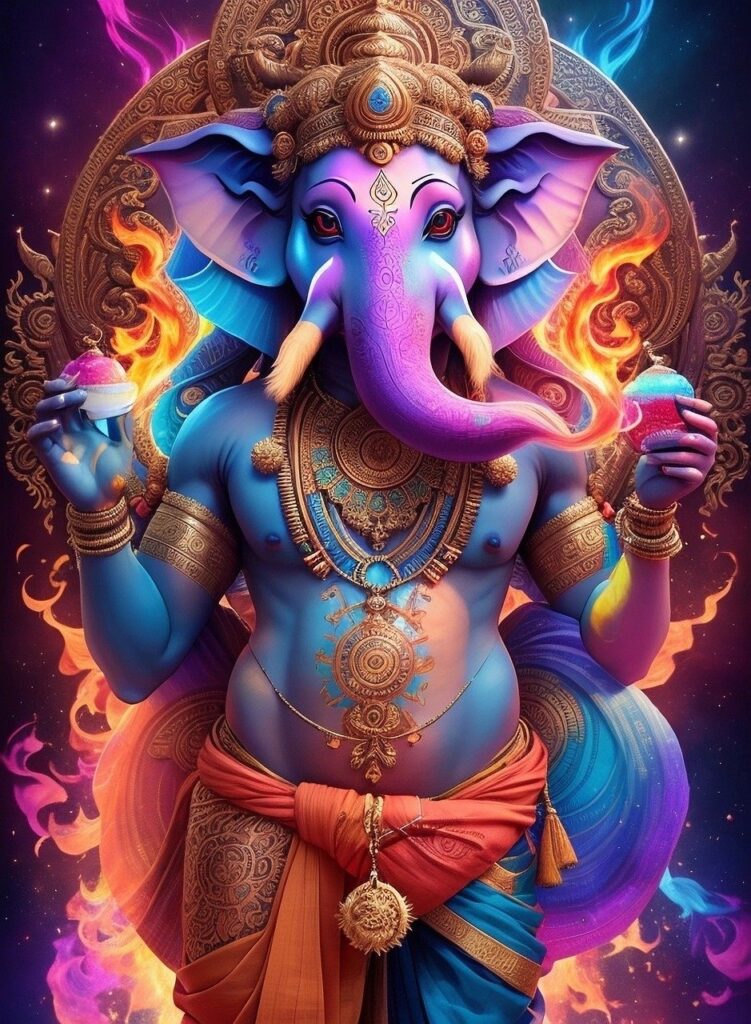Ganesha Tusk: The Fascinating Tale of Lord Ganesha’s
Introduction
Deity Ganpati or Vinayaka, alternative names for Lord Ganesha, occupies a prominent position within Hindu mythology. Beholden to the deity of intellect and wisdom, he is venerated as the remover of obstacles and the initiator of rituals and ceremonies. A noteworthy element within the iconography of Lord Ganesha is the portrayal of him holding a shattered tusk. This article examines the symbolism associated with the fractured tusk of Lord Ganesha and proceeds to delve into the captivating tales that surround this distinctive attribute.
The Story from the Brahmanda Purana
As stated in the Brahmanda Purana, the shattered tusk of Lord Ganesha is the subject of an intriguing narrative. Bhagwan Parshuram, the sixth incarnation of Vishnu, wished to convey his appreciation to Lord Shiva for endowing him with power. Nevertheless, upon his arrival at Mount Kailash, Lord Ganesha, in his capacity as an obedient son, forbade him from interrupting his parents’ slumber. This provoked Parshuram and Lord Ganesha into a fierce battle, which enraged him.
Lord Ganesha willingly accepted the axe that Parshuram hurled at him during the battle, considering it a bequest from his father, Lord Shiva. In recognition of the offering, Lord Ganesha received the strike with his left tusk, which subsequently fell to the ground. This occurrence represents the selflessness and adoration of Lord Ganesha towards his parents.
“Perceiving that the axe had been given to him by his father, Ganesha became desirous of meaning it not to go in vain. Hence he received it with his left tooth (tusk). Chopped off by the axe, the tusk fell on the ground, covered with blood like a mountain that fell on the ground when struck by Indra’s thunderbolt.” – Brahmanda Purana

The Story from the Mahabharata
The fractured tusk of Lord Ganesha is the subject of an additional well-known tale that appears in some versions of the Mahabharata. Sage Maharishi Ved Vyasa requested the aid of Lord Ganesha in the process of transcribing the verses of the epic. On the condition that Maharishi Ved Vyasa recite the verses continuously and without interruptions, Lord Ganesha agreed to assist.
In order to provide Maharishi Ved Vyasa with sufficient time to reflect and contemplate the significance of the verses, he imposed his own condition. Before composing a verse, Lord Ganesha would only compose if he had a complete understanding of it. As Maharishi Ved Vyasa swiftly recited the epic, the ink on Lord Ganesha’s pen started to deteriorate. To sustain his writing endeavors, Lord Ganesha severed a portion of his own tusk and employed it as a writing implement.
“It is believed that when Lord Ganesha was writing, his pen began to wear away, and as He had always proclaimed that He would not be disturbed, He pulled out his left tusk and used it to complete writing the great epic Mahabharata.” – Mahabharata
The Story of Ganesha and the Moon

An additional captivating anecdote links the shattered tusk of Lord Ganesha to the moon. Following his attendance at a banquet held at the palace of Kubera, Lord Ganesha rode his mouse back home during the night of the full moon. His mouse abruptly detected a serpent and fled behind a shrub, precipitating Lord Ganesha’s fall to the ground. His stomach ruptured in the autumn, causing the contents of the foods he had ingested to leak.
Upon observing this, the moon deity erupted in laughter, to the ire of Lord Ganesha. As a reaction, Lord Ganesha hurled one of his tusks towards the moon, causing it to splinter in two. Due to this occurrence, the moon was doomed to perpetual darkness and abstain from public observation. Later, Lord Ganesha granted the moon deity pardon, but he ordained that on the day of his birthday, no one would achieve liberation by beholding the moon.
Symbolism of Lord Ganesha’s Broken Tusk

The shattered tusk of Lord Ganesha functions as a profound symbol. It symbolizes the sagacity that results from transcending duality and acknowledging the unity of the universe. Duality, which alienates “me” from the remainder of existence, is an illusion generated by the mind, according to Hindu philosophy. The shattered tusk of Lord Ganesha represents how an enlightened individual transcends this duality and recognizes the interdependence of everything.
Through his decision to continue penning the Mahabharata despite fracturing his tusk, Lord Ganesha demonstrates selflessness for the greater good. This action exemplifies his dedication to carrying out his responsibilities and keeping his word. In order to accomplish a greater goal, sacrifices are occasionally necessary, as symbolized by the shattered tusk of Lord Ganesha.
Conclusion
The narratives surrounding the shattered tusk of Lord Ganesha are replete with teachings and symbolism. They emphasize his wisdom, devotion, and selflessness. The shattered tusk of Lord Ganesha conveys the message that despite challenges, greater accomplishments are possible through sacrifice, and that by transcending duality, we can attain a deeper comprehension of our authentic selves.
Lord Ganesha continues to guide and inspire devotees on their spiritual journeys via these anecdotes. The shattered tusk he bears serves as a potent emblem of resolve, altruism, and the victory of sagacity over duality. During our veneration of Lord Ganesha, may we bear in mind the profound meaning embodied in his shattered tusk and endeavor to emulate the virtues it symbolizes.
#tusk #ganesha #ganeshtusk #ganeshatusk #brokentusk #tuskofganesh #story








